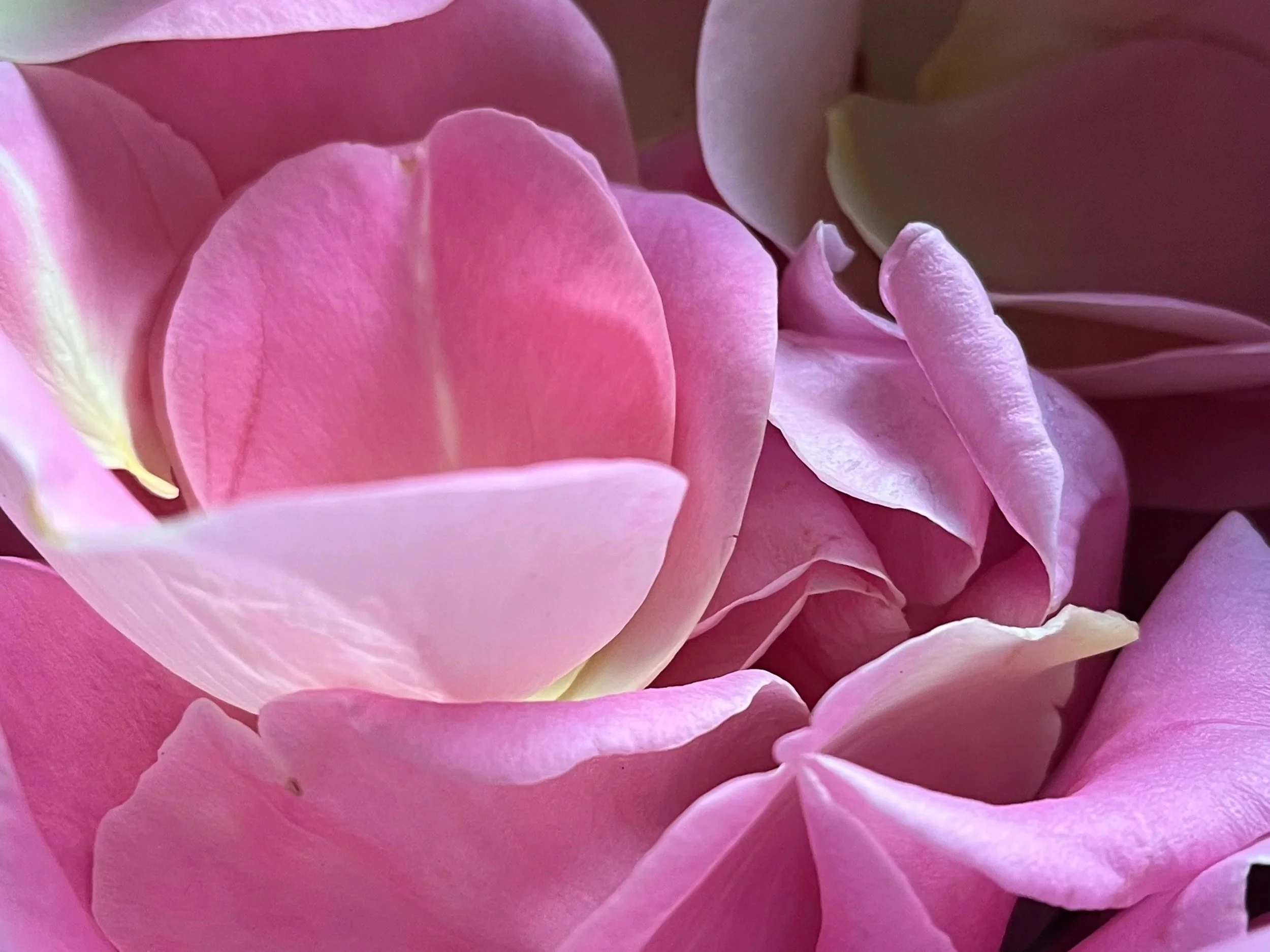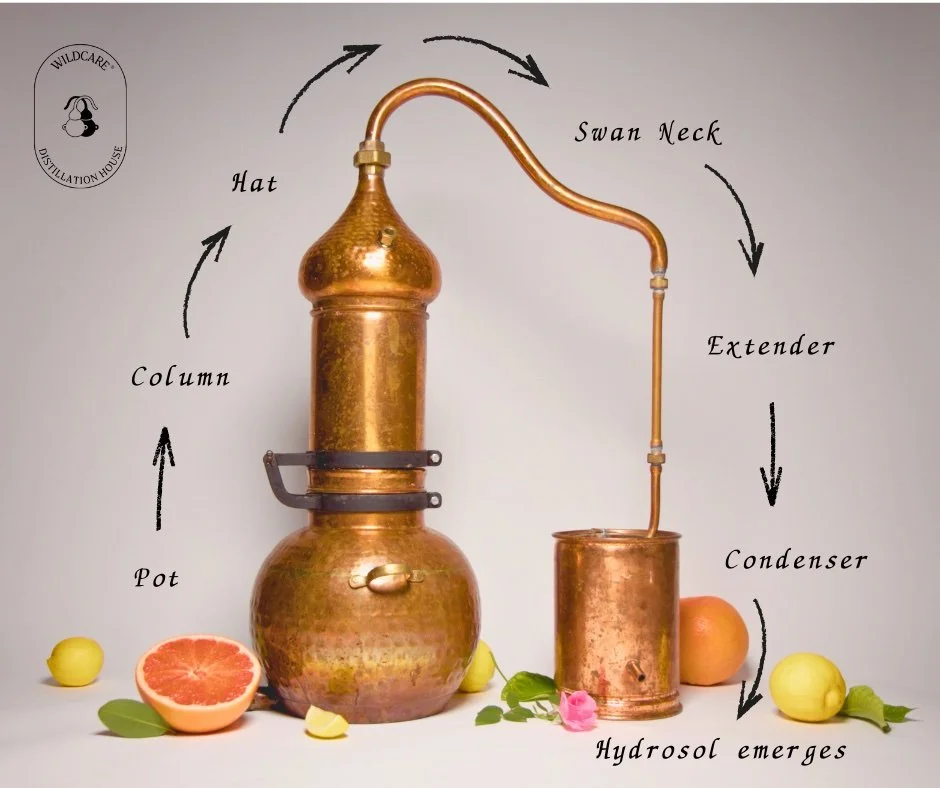What is a Hydrosol?
Hydrosols, also referred to as distillates, hydrolats, or floral waters, are the subtle and often aromatic waters resulting from slowly distilled plant material.
The Distillation Process
First, the pot which is holding the freshly collected spring water is slowly heated. The pot may or may not contain plant material depending on what is being distilled. The column, if steam-distilling, is where plant material is packed. As the steam rises in the hat, it passes through the plant material in the form of vapor, carrying vital nutrients, plant acids, and suspended particles of essential oil through the swan neck. As this energetic vapor reaches the condenser, it cools and through the alchemical process of distilling it emerges in the form of an aromatic water (now a Hydrosol) along with its essential oil counterpart. larger stills, the essential oil will rise to the top, leaving the Hydrosol with roughly 0.1% micro-particles of essential oil.
The Hydrosol may be ‘matured’ as the scent shifts after distillation, but with copper stills, it is not needed. It is then ready to use as a holistic and energetic tool. In addition to it carrying the nutrients and healing benefits from the specific botanical distilled, many believe it also carries the plant's life essence and memory imprint. One of the greats of our time, Jeanne Rose, stated “The act of distillation is the process or art whereby the invisible is made visible”. You may notice that given thoughtful attention, the individual vibration of the plant's landscape and the unique charge of where and when it was harvested, the smell that was in the air and the elements that encouraged its growth may come through. These waters are precious and capable of great healing, containing all of the plant in a single drop.
Hydrosols in History
Alchemists from all over the world have performed transformational, healing distillations for well over 4,000 years; an artful process we are humbled to participate in and carry forward today. The first stills we know of were created from clay, using the sun and/or fire to heat the still, gently extracting a plant's oil and aromatic waters found in many various sites from Cyprus, to Turkey, what is now Iraq, Persia, Egypt, China, the list goes on and the data continues to change as more vessels are discovered, tested and explored. It appears they were utilized first for medicinal waters and later perfumery. The term ‘alembic’ that we still use today, is an Arabic-derived word, where distillation techniques and design became more precise and design improved and transformed with copper stills, before it evolved. One of the most prominent Hydrosols in ancient texts we’ve found has been the use of delicate rose water, which is remarkably still used today. Other texts show waters of Plantain, Rosemary, Coriander and Lavender were plants being worked with in the stills found in Cyprus. In the 16th century, the design of the copper still was improved, allowing for a more effective distillation process with its rotating column channel as well as increasing yields, and by the 18th century, Rose, Orange Blossom, and Geranium Hydrosols were most commonly distilled plants used to nourish the skin. When the essential oil industry became more commercialized for their potency and aromatics, Hydrosols focus became that of a byproduct, and slowly became a forgotten gem. Thankfully today, we are seeing Hydrosols return, with a renewed interest in its precious mist. Even in the last 10 years since we began offering our distillations which at that time required a lot of customer education, Hydrosols have become staples as a crucial component of the skincare world.
* Click over to read my Substack if you’d like to dive in more with my personal journal on distilling as Matter, Art and Alchemy.
How to Use
Hydrosols are incredibly gentle and subtle waters. Contrary to their essential oil counterparts, they have virtually no health contradictions and warnings, and are well-suited for beings of all ages and sensitivities (including babies and pets alike). Wildcare Hydrosols are recommended as a daily facial toner and energetic mist, playing an important role in protecting and nourishing the skin from everyday pollutants.
In addition to tonifying the skin, your Hydrosol may also be used as a holistic and energetic mist for mood, as a scalp tonic, added to baths, and used in conjunction with our Clay Masks. Hydrosols are precious ancient remedies, and some of natures most pure antioxidants for the skin. Mist as often as desired for a boost of hydration and refreshment. Our favorite method is misting as a toner after washing the face, and misting again after moisturizing with an oil to lock in the hydration. Your daily consistent use restores the skin’s natural PH balance and allows for a more hydrated complexion.
Hydrosol + Oil
Because the skin is made up of water in the form of sweat and oil aka sebum, utilizing a hydrosol and a facial serum or oil together aids in establishing the skin’s inherent rhythm. Essentially, you’re creating your own fresh moisturizer without the fillers and preservatives of a common face cream. When layered in your ritual, the Hydrosol carries in the moisture from your oil, while your facial oil helps to hold the hydrosol waters close to the skin. This means that those pH balancing plant acids, healing nutrients and potent antioxidants found in both are able to penetrate more efficiently leading to dewy, healthy skin that is properly hydrated and moisturized.
Care
Always remember to store your Hydrosol in a cool, dark place. Direct sunlight and heat can damage their precious molecules. Keep the cap tightly closed, refraining from opening the bottle. The best way to check for damage is by holding it up to the light and confirming it's clear. If a cloud-like apparition is seen, known as a "bloom", it means your Hydrosol has been contaminated by either airborne or direct contact with bacteria and should be discarded.
Preservatives aren't needed for Hydrosols as long as proper care is followed. For extra cooling skin relief and prolonged shelf life, you may keep it in the refrigerator -this makes a lovely summertime refresher!
We recommend using your Hydrosol within 6 months, but they can maintain freshness up to 1 year.







